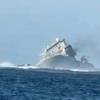A major step forward in tanker operation safety was taken as ABS announced technical guidance for inert gas systems for ballast tanks. Compliance to the guidelines leads to the class notation IGS-Ballast. ABS is the first society to set standards and offer a notation for complying with design criteria and procedures for inerting ballast tanks on double hull tankers.
The timely introduction of the ABS Guide For Inert Gas System For Ballast Tanks addresses industry concerns regarding the potential leakage of volatile gases from oil laden cargo tanks into the ballast or void spaces. This concern has been further heightened as double hull tanker configurations become the standard with mandated phase in by 2010.
“Leakage of oil into the double hull ballast space for tankers, even from minor cracking or corrosion pitting, can lead to volatile gas build up in these spaces. Installation of an appropriate inert gas system reduces oxygen levels, thus reducing the atmospheric conditions that could lead to risk of explosion in the ballast tanks,” explains Yoshi Ozaki, Manager, Marine Engineering Systems, ABS.
Along with design criteria for the systems and guidance procedures on properly inerting (reducing the oxygen content of the atmosphere) and gas-freeing (introducing fresh air into the tank’s atmosphere) the ballast tanks, another important secondary benefit gained from the ABS guide is the control of corrosion in the ballast tanks. “By reducing the oxygen content in the space you can control or reduce corrosion,” adds Ozaki. “An inert condition exists when the oxygen content throughout the ballast tank’s atmosphere has been reduced to 5 percent or less by volume. By introducing inert gas such as nitrogen or a mixture of gases containing a reduced level of oxygen this decreases the corrosion rate.”
The practical guidance offered by ABS to effectively inert and gas-free the ballast tanks was developed in part by using Computational Fluid Dynamics or CFD analyses of the introduction of oxygen or inert gas in a space over time. “Computer simulation allows us to apply basic physics principles to the flow of gases or oxygen over time to create real time modeling of a ballast tank’s atmospheric environment,” says Ozaki. “With this information we can create inerting or gas-freeing scenarios to then write practical procedures for the process.”
The Guide and appendix covers system design for dedicated inert gas systems as well as common inert gas systems for ballast tanks and cargo tanks; ballast tanks venting; ballast tank gas detection systems and survey requirements for the new construction of the systems and the annual and special periodic survey requirements.
Currently 30 percent of all tankers on order are to ABS class. In terms of existing tonnage, the society has 45.4 million gt of tanker tonnage within its class.
Sponsored Content
ALMACO Group Completes Extensive Refurbishment on The Aroya

Subscribe for
Maritime Reporter E-News
Maritime Reporter E-News is the maritime industry's largest circulation and most authoritative ENews Service, delivered to your Email five times per week











